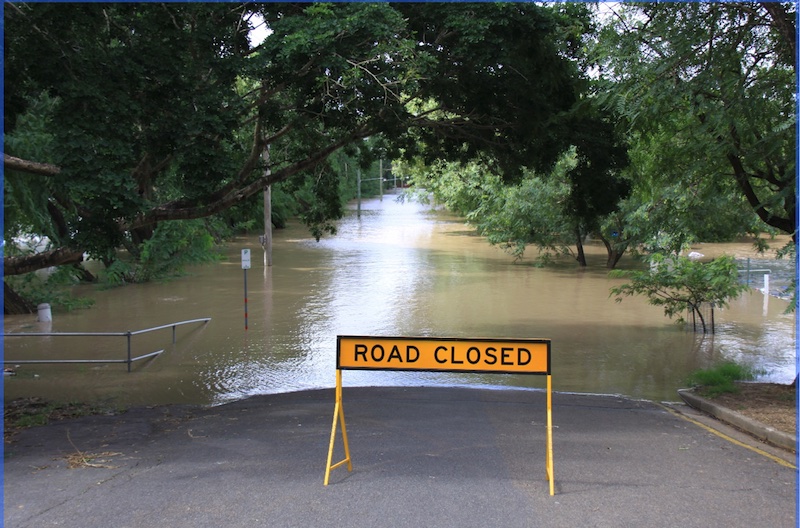About 7% of Australian addresses have some flood risk and about 2.8% have a moderate to extreme risk of flood.
Floods can develop quickly or slowly, and they can affect small areas such as a single suburb or vast areas across state boundaries.
Floods can happen within a few minutes or hours of heavy rainfall, a dam or levee failure or when a creek or river breaks its banks, or flooding can occur after several days of heavy rainfall when the ground becomes saturated.
In many parts of Australia, a river or creek can flood weeks after a storm or cyclone hits several thousand kilometres away.
Flood risk is not based solely on an area’s history of flooding; factors including rainfall, topography, flood mitigation and changes to the landscape caused by new infrastructure or developments can all cause exposure to flooding.
Flood insurance is available in a variety of formats designed to suit individual circumstances. If you're not sure about your flood risk, contact your local council or flood plain management authority.
Before a flood
Planning ahead is the best way to protect your family, home, business and assets from flood damage. Insurance helps to do this, so review your insurance policies and ensure your level of cover is appropriate.
Familiarise yourself with your local council’s emergency management plan or any flood-awareness material provided by local councils.
Property owners can take various steps that may reduce the level of impact experienced during a flood, including:
- Prepare a household inventory of the contents of your home and avoid being under insured by checking that the sum insured matches the value of your home and contents
- Prepare a disaster plan that sets out what to do, where, when and how to manage property and family during a flood
- Prepare a disaster supply kit, with cash, food, water, toiletries, medication, your household contents inventory, copies of important documents, protective clothing, a radio and a torch – and batteries for both
- Check you have comprehensive car insurance. Remember that compulsory third-party insurance does not cover you for damage to your vehicle
- Know where and how to turn off mains power, water, gas and solar power
- Decide on the best strategy to protect your pets and other animals
During a flood
If you are experiencing a flood there are practical steps you can take to stay safe and minimise damage to your property. This includes:
- Enact your disaster plan and follow the instructions of local authorities and emergency services
- If possible, lift furniture, clothing and valuables off the ground so they don’t get wet
- Ensure electrical equipment is unplugged and mains power, water, gas and solar power is turned off
- Have waterproof bags ready to protect clothing and important documents from storm damage
- Avoid entering floodwater on foot or in a vehicle. Floodwater can contain raw sewage and contaminants, conduct electricity and can mask hidden hazards. It can be deeper than you think and may be flowing rapidly.
- Stay informed and listen to ABC Local Radio and visit the Bureau of Meteorology website for updates.
What to do when you return to your property after flood
- Safety is the priority - don’t do anything that puts anyone at risk.
- Only return to your property when emergency services give the go ahead.
- If water has entered the property, don't turn on your electricity until it has been inspected by an electrician.
- Contact your insurance company as soon as possible to lodge a claim and seek guidance on the claims process.
- Don’t worry if you can’t find your insurance papers. Insurers have electronic records and need only your name and address.
- You can start cleaning up but first take pictures or videos of damage to the property and possessions as evidence for your claim.
- Keep samples of materials and fabrics to show your insurance assessor.
- Remove water or mud-damaged goods from your property that might pose a health risk, such as saturated carpets and soft furnishings.
- Make a list of each item damaged and include a detailed description, such as brand, model and serial number if possible.
- Store damaged or destroyed items somewhere safe.
- Speak to your insurer before you attempt or authorise any building work, including emergency repairs, and ask for the insurer’s permission in writing. Unauthorised work may not be covered by your policy.
- Do not throw away goods that could be salvaged or repaired.
- Do not drive your vehicle if it has suffered water damage.
Urgent financial need
If you need urgent financial assistance let your insurer know, they may be able to fast track your claim and make an advance payment within five business days of you demonstrating your urgent financial need. Any advance payment may be deducted from the total value of your claim.
If your claim has been finalised within one month of the disaster, your insurer must give you six months from the finalisation date to ask for a review of your claim (for instance, if you think the insurer has not accurately assessed your loss), even if you have signed a release.




